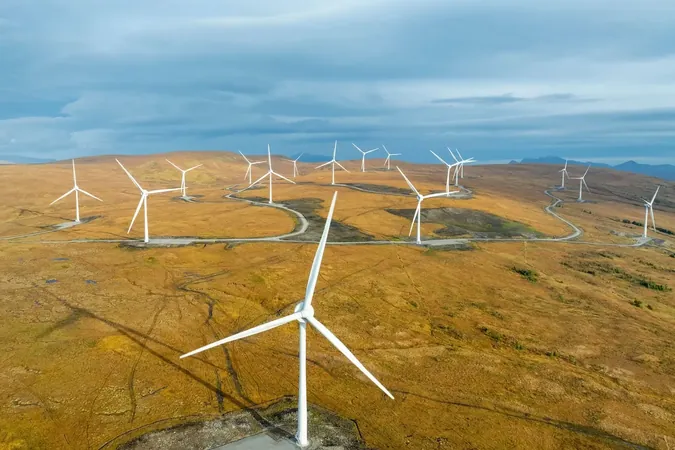
Chilling News for Wind Power: Climate Change Could Extend 'Wind Droughts' by 15%
2025-07-30
Author: Yu
A Dire Forecast for Wind Energy
The world of wind energy faces a looming crisis as a new study reveals that climate change could prolong 'wind droughts'—periods of low power output from turbines—by a staggering 15% by the end of this century. This alarming prediction comes from a recent research published in *Nature Climate Change*, which delves into the potential impacts of global warming on prolonged low-wind events.
Where Are Wind Droughts Already Happening?
Wind droughts have already left their mark in key regions including Europe, the United States, northeastern China, Japan, and India. According to the study, as temperatures rise, such droughts are set to become increasingly frequent and extended across the northern hemisphere and mid-latitudes, particularly affecting the US, northeastern China, Russia, and much of Europe.
The Threat to Energy Security
The implications are serious. Prolonged wind droughts not only jeopardize global wind power security, but they also risk pushing energy prices sky-high as countries scramble for alternatives, often resorting to expensive fossil fuels. Experts warn that while wind energy is a crucial component in the shift towards cleaner energy systems, these droughts could severely impact its reliability.
Wind Power's Role in Decarbonisation
Currently generating around 8% of the global electricity supply, wind power is one of the fastest-growing energy sources. However, the uneven heating of Earth due to climate change is leading to altered wind patterns, with recorded average wind speeds slightly decreasing over the last four decades—excluding Australia. These changes result in higher susceptibility to wind droughts.
The Unseen Costs of Wind Droughts
Dr. Iain Staffell, an associate professor at Imperial College London, highlights that wind droughts can lead to spikes in electricity prices, as illustrated by a severe cold spell in Germany during the winter of 2024-25, which sent prices to record highs. Thankfully, he notes that no region has ever experienced a blackout solely due to a wind drought.
What's Next for the Wind Industry?
The study, however, isn't all doom and gloom. Experts suggest that it can serve as a navigation tool to help the energy sector prepare for the upcoming challenges posed by climate change. By combining wind power with solar, hydro, nuclear, and energy storage solutions, the negative impact of wind droughts can be mitigated.
Understanding Capacity Factors and Extreme Events
Wind productivity is measured by capacity factors. The research evaluates the duration and frequency of wind droughts, projecting a noticeable increase in wind drought durations across the northern mid-latitudes. Particularly concerning are the 'extreme long-duration events' expected to once-in-a-25-year frequency, which may elongate by up to 20% in certain regions.
Preparing for Record-Breaking Droughts
The researchers even explored the risk of record-breaking wind droughts, which could last between 150 to 400 hours in various parts of the world. Global projections indicate that around 15% of wind turbines could face severe risks from these extreme events by the century’s end.
Future of Wind Energy: Mitigation Strategies
As the planet aims for 6,000GW of wind power capacity by 2050, developers are advised to innovate by steering clear of areas prone to wind droughts. Effective mitigation strategies include enhancing interconnections between countries' power grids to effectively share resources during low-wind periods.
A Call for Resilience in Energy Supply
Experts assert that these findings do not threaten the viability of wind energy; rather, they underline the importance of resilience and flexibility in power systems. A well-diversified energy mix can not only safeguard against extreme weather but also prevent the panic-driven reliance on gas when the winds die down.
Concluding Thoughts
The future of wind power will hinge on how effectively the industry adapts to these climatic shifts. By investing in energy storage and boosting grid connectivity, regions can continue to harness the power of wind while navigating the challenges posed by climate change.



 Brasil (PT)
Brasil (PT)
 Canada (EN)
Canada (EN)
 Chile (ES)
Chile (ES)
 Česko (CS)
Česko (CS)
 대한민국 (KO)
대한민국 (KO)
 España (ES)
España (ES)
 France (FR)
France (FR)
 Hong Kong (EN)
Hong Kong (EN)
 Italia (IT)
Italia (IT)
 日本 (JA)
日本 (JA)
 Magyarország (HU)
Magyarország (HU)
 Norge (NO)
Norge (NO)
 Polska (PL)
Polska (PL)
 Schweiz (DE)
Schweiz (DE)
 Singapore (EN)
Singapore (EN)
 Sverige (SV)
Sverige (SV)
 Suomi (FI)
Suomi (FI)
 Türkiye (TR)
Türkiye (TR)
 الإمارات العربية المتحدة (AR)
الإمارات العربية المتحدة (AR)